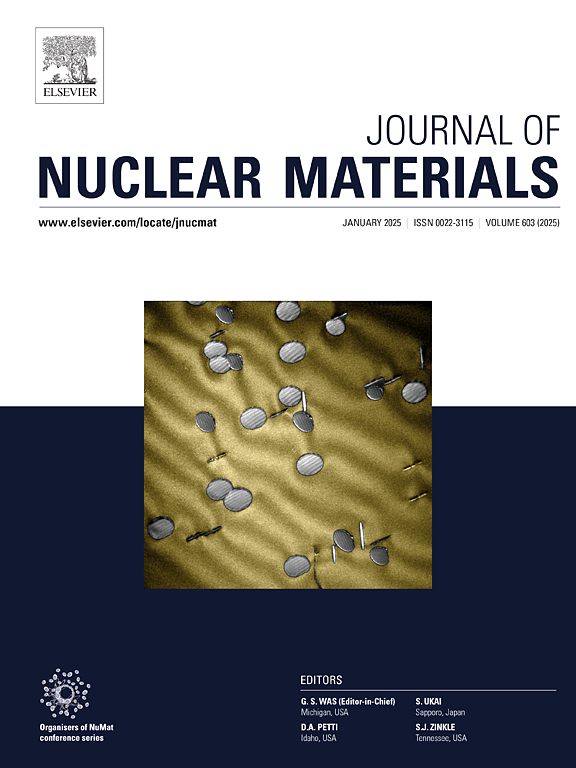Dependence of corrosion fatigue crack propagation rate of 316LN stainless steel on dissolved hydrogen concentration in simulated PWR primary circuit loop water
IF 2.8
2区 工程技术
Q3 MATERIALS SCIENCE, MULTIDISCIPLINARY
引用次数: 0
Abstract
This study investigates the corrosion fatigue crack propagation behavior of 316LN stainless steel (SS) under asymmetric loading mode in a simulated pressurized water reactor (PWR) circuit loop water environment containing dissolved hydrogen (DH) of 0, 18, 30, and 50 cm3 (STP) H2/kg H2O (cc/kg) at 320 °C. The corrosion fatigue crack propagation rate (CFCPR) of 316LN SS exhibits a non-monotonic response to the DH concentration, following the sequence: CFCPR (DH = 0 cc/kg) > CFCPR (DH = 18 cc/kg) > CFCPR (DH = 30 cc/kg) < CFCPR (DH = 50 cc/kg). CFCPR values at all DH conditions exceed the ASME code case N-809 reference curve. The corrosion fatigue regions on the fracture surfaces of specimens tested under all DH concentrations show similar transgranular cracking characteristics. Electrochemical reactions at the crack tip region during the corrosion fatigue propagation under the extended loading rise time could principally influence crack propagation, where the relatively high strain rate condition retards the formation of a stable oxide film at the crack tip, thus facilitating alloy dissolution. The occurrence of the minimum CFCPR at DH = 30 cc/kg suggests the importance of the combined effects of DH concentration on alloy dissolution kinetics, oxide film formation kinetics, and potentially oxide film properties.The synergistic interaction between the extended loading rise time and DH concentration governs the corrosion fatigue crack propagation behavior.
模拟压水堆一次回路水中溶解氢浓度对316LN不锈钢腐蚀疲劳裂纹扩展速率的影响
本文研究了316LN不锈钢(SS)在不对称加载模式下,在320°C的模拟压水堆(PWR)回路水环境中溶解氢(DH)分别为0、18、30和50 cm3 (STP) H2/kg H2O (cc/kg)的腐蚀疲劳裂纹扩展行为。316LN SS的腐蚀疲劳裂纹扩展速率(CFCPR)随DH浓度呈非单调响应,其顺序为:CFCPR (DH = 0 cc/kg) >;CFCPR (DH = 18 cc/kg) >;CFCPR (DH = 30cc /kg) <;CFCPR (DH = 50cc /kg)。所有DH条件下的CFCPR值都超过ASME规范案例N-809参考曲线。各浓度下试样断口表面腐蚀疲劳区表现出相似的穿晶开裂特征。延长加载上升时间下腐蚀疲劳扩展过程中裂纹尖端区域的电化学反应主要影响裂纹扩展,较高的应变速率条件延缓了裂纹尖端稳定氧化膜的形成,从而有利于合金的溶解。最低CFCPR在DH = 30 cc/kg时出现,这表明DH浓度对合金溶解动力学、氧化膜形成动力学和潜在氧化膜性能的综合影响很重要。延长加载上升时间与DH浓度之间的协同作用支配着腐蚀疲劳裂纹扩展行为。
本文章由计算机程序翻译,如有差异,请以英文原文为准。
求助全文
约1分钟内获得全文
求助全文
来源期刊

Journal of Nuclear Materials
工程技术-材料科学:综合
CiteScore
5.70
自引率
25.80%
发文量
601
审稿时长
63 days
期刊介绍:
The Journal of Nuclear Materials publishes high quality papers in materials research for nuclear applications, primarily fission reactors, fusion reactors, and similar environments including radiation areas of charged particle accelerators. Both original research and critical review papers covering experimental, theoretical, and computational aspects of either fundamental or applied nature are welcome.
The breadth of the field is such that a wide range of processes and properties in the field of materials science and engineering is of interest to the readership, spanning atom-scale processes, microstructures, thermodynamics, mechanical properties, physical properties, and corrosion, for example.
Topics covered by JNM
Fission reactor materials, including fuels, cladding, core structures, pressure vessels, coolant interactions with materials, moderator and control components, fission product behavior.
Materials aspects of the entire fuel cycle.
Materials aspects of the actinides and their compounds.
Performance of nuclear waste materials; materials aspects of the immobilization of wastes.
Fusion reactor materials, including first walls, blankets, insulators and magnets.
Neutron and charged particle radiation effects in materials, including defects, transmutations, microstructures, phase changes and macroscopic properties.
Interaction of plasmas, ion beams, electron beams and electromagnetic radiation with materials relevant to nuclear systems.
 求助内容:
求助内容: 应助结果提醒方式:
应助结果提醒方式:


